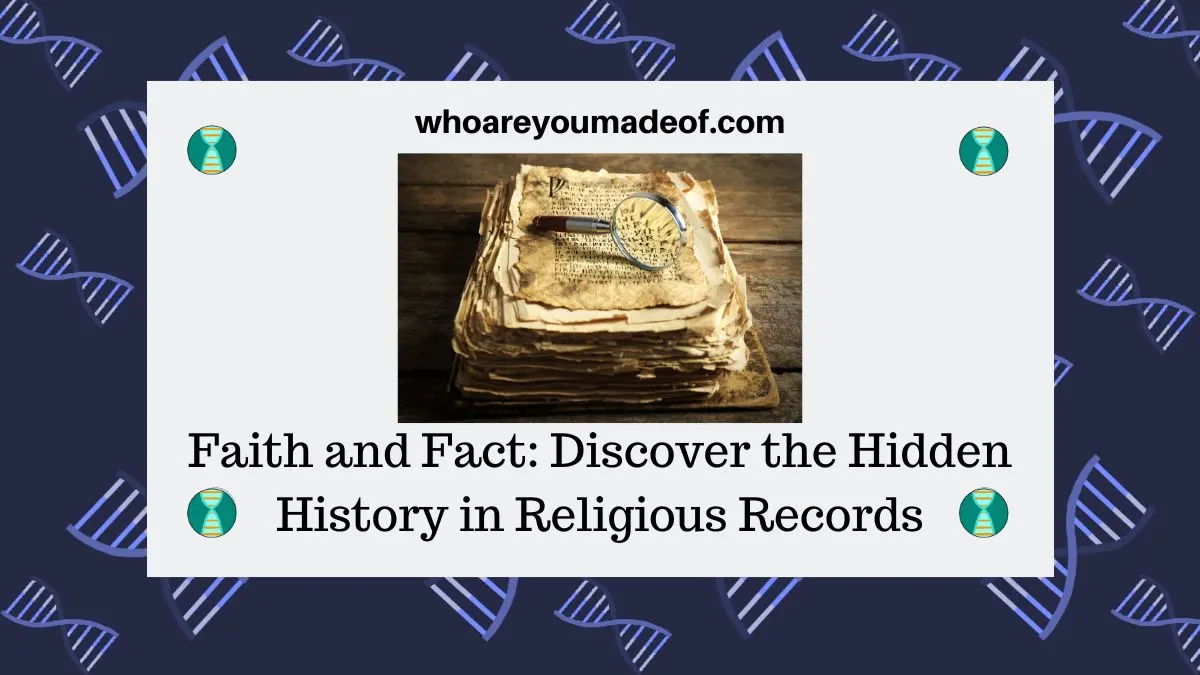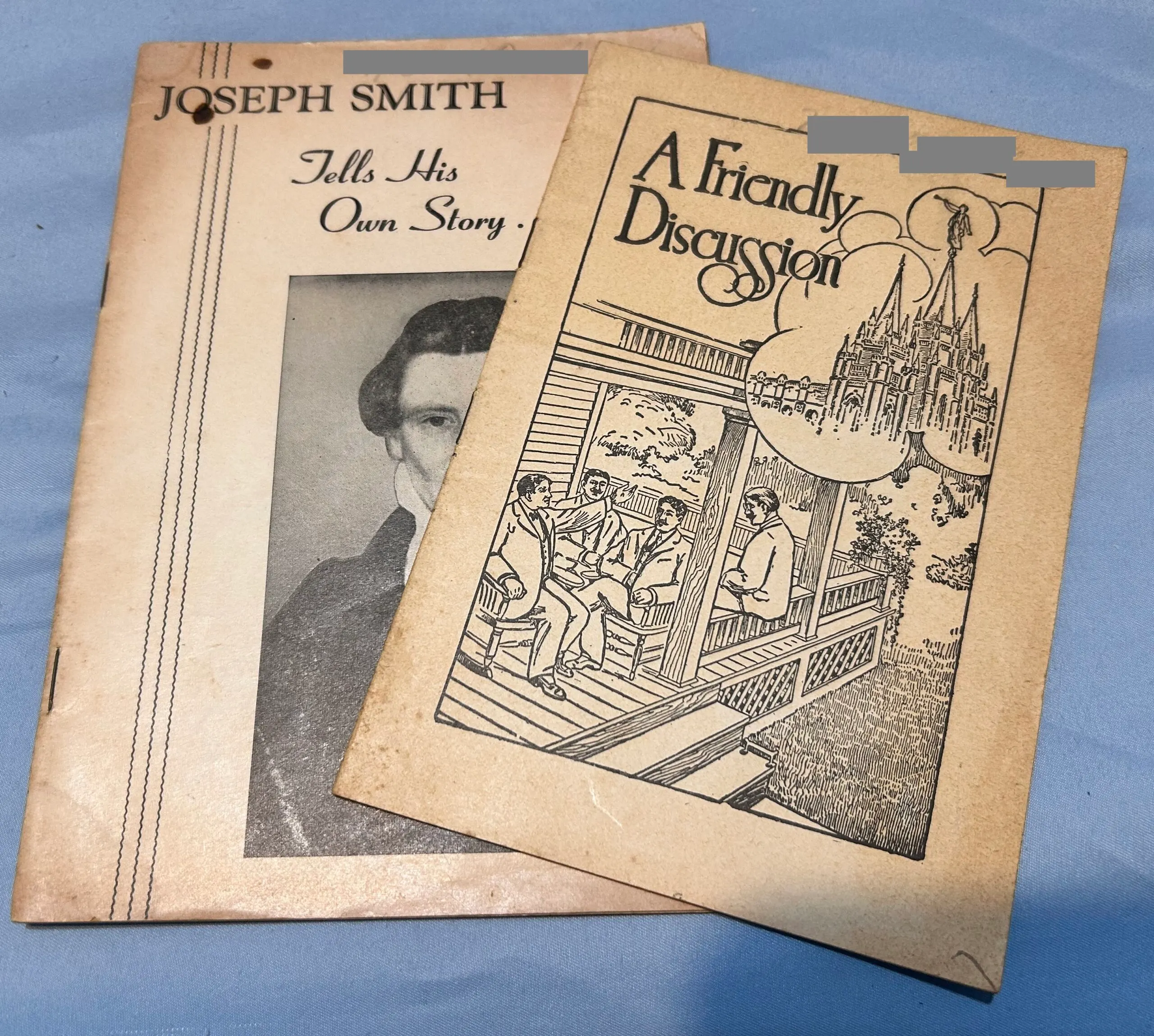Did you know that your ancestor's religious records might reveal hidden facts about their life? You could discover information that you wouldn't be able to learn any other way.

About twenty years ago, my grandmother gave me an old dresser that had belonged to her grandmother, my great-great grandmother. The small dresser was still full of her belongings, which I found interesting to search through, even though this was well before my interest in genealogy fully developed.
The bottom drawer of the dresser contained zip-lock bags of her old sewing and knitting supplies - nothing too exciting. To my surprise, below all of these supplies were a couple of pamphlets printed by the Mormon Church, with my great-great grandmother's name written in pencil on the upper right corner.

As far as I knew, my great-great grandparents had been Methodists. I knew this because my grandmother was Methodist, and she told me that her parents and grandparents had all been Methodist, too.
So of course, it was strange to find Mormon literature tucked underneath some of my great-great-grandmother's belongings. I had more questions than answers.
One question was whether my great-great grandmother, whose name was Mabel, had been hiding these pamphlets? Where did she get them, and why did she keep them?
Clearly they meant enough to her to write her name on them and preserve them for decades.
I didn't know whether there would ever be any way to figure out the answer to these questions, so I put the pamphlets, as well as my lingering questions aside, for the next decade.
As my skills and interest as a genealogist developed, I began to focus more on learning about my great-great grandmother's line of my tree. To my surprise, I received an Ancestry hint for a religious record which indicated that Mabel's grandfather was endowed by the Mormon Church as an early member of the Quorum of the Seventy.
To make a long story short, Mabel's grandfather was involved in the church leadership back in the 1840s, and this was likely why she had an interest in the Mormon Church. I have since discovered more about my great-great-great-great grandfather's life, which I will discuss in more detail towards the end of this article, for those who are interested.
For now, let's move on to learning how your ancestor's church and other religious records can help you learn things about them that you might not be able to otherwise discover.
What you can learn from religious documents
When I first started out learning about how to build my family tree, I thought that the only thing I could really learn from religious documents, such as baptismal records, was to which religion my ancestor belonged.
As it turns out, there is much more to learn from exploring our ancestor's spiritual and religious lives. You are sure to uncover many fascinating things about your ancestors by viewing this type of genealogy record.
Religious records might be the only way to trace your ancestors
If the ancestor you want to learn more about lived their life before the 1900s, religious records might be the only way for you to trace their family through history. This is because legal requirements for governments to maintain vital records are relatively new.
For example, in Mexico, governmental authorities began the custom of creating vital records in 1859. In England and Wales, civil registration began in the 1830s.
In the United States, the history of civil registration reveals a patchwork of rules and requirements. Most people in the United States had their births and deaths registered by the 1930s, though some states had civil registration requirements as early as the early 1800s.
You might learn who their parents and grandparents were
Many religions have a custom of including the names of parents and grandparents on religious documents like marriage records. By finding your ancestors' religious marriage record, you might be able to see who their parents were.
You might find out what your ancestors did for a living
Some religious records might include information about the occupation of your ancestor or their parents. For example, I was able to learn that one of my German 4th great-grandfathers was a "journeyman miller" because it was written on his daughter's marriage record.
Through learning more about what this occupation was, and its significance in the broader context of Germany in the 1860s, I can learn more about my ancestor's social standing. This could even provide me clues as to how and why my ancestor's daughter immigrated alone with her children to the United States.
You can learn about their social network
Many Christian denominations follow the religious rite of baptism. Children who are to be baptized often have godparents, sometimes called sponsors, which are chosen by the parents.
Sometimes, parents choose close friends to be godparents. By researching the godparents on your ancestor's baptismal record, you can learn who your ancestor's depended on in their social network.
One of my cousins found that his great-grandfather's godparents were his parents neighbors from back home in Poland. Their names helped him find out the name of the town in Poland where his Polish ancestors were from.
Discover which relatives they were closest to
You might find names of other relatives on your ancestor's religious records. Some of these records might include sponsors or godparents who were chosen by the parents because they are close relatives involved in the child's life.
If you research these names, you might discover relatives you didn't know about - and entire collateral lines of your family tree.
You might find out more about their social status
Your ancestor's religious records could help you learn about your ancestor's social status in their community. Aside from their occupation, which I mentioned above, there are other details that can provide clues.
For example, I learned that wealthier people in my husband's hometown in Mexico often traveled to a specific town with a cathedral to baptized their children. Another example of social standing displayed in religious records is the rank of the officiant, as wealthier people may have requested a higher ranking officiant for their ceremonies.
You may be able to find out where your ancestor is buried
Religious records documenting one's death may be able to help you learn where your ancestor is buried. Once you know where they are buried, you may be able to find additional relatives by searching through other burial records at the same cemetery on sites such as Find-a-Grave.
Religious records can help confirm details about your ancestor's life
You can use your ancestor's religious records to confirm things that you have learned about your ancestor through other records. These records could also help resolve confusing when you are trying to figure out which record for people with the same or similar name belongs to your ancestor.
You might discover which country your ancestor came from through their church records
Sometimes, we may be able to figure out where our ancestors came from by finding their religious records. Immigrants to the United States were often members of the same religious denomination as in their country of origin, but they may have gone to a church where most of the members spoke their native language.
At these churches, the records were often kept in the native language. By finding these records, you can learn more about your ancestor's origins.
The rest of the story about Mabel's grandfather - and more questions
I have done a lot of research on Mabel's grandfather, the ancestor who I discussed earlier in this article, even though I still have a lot that I hope to learn. He was an early member and leader in the Mormon Church.
Through my searching, I was able to learn that Mabel's grandfather lived for a time in Oswego County, New York, only about an hour away from Palmyra, the place where Joseph Smith, the founder of the Mormon Church, lived much of his younger life. While I don't know how my ancestor got involved with the Mormons, the geographic proximity between these two places could provide a clue.
My ancestor ended up moving from New York to Carroll County, Missouri. He was still living there during the time of the Mormon War of 1838. In fact, he was one of the signatories in a letter in September 1838 from a group of Mormons to then governor of Missouri, Lilburn Boggs, requesting help in defending their settlement against violent incursions from many non-Mormon citizens of Carroll County who wished to see them leave the area.
History shows that the Mormons did leave Missouri. While I don't know exactly how and why, by 1840 my ancestor was living in LaSalle, Illinois, a few hours from where the Mormon Nauvoo temple would eventually be built.
My ancestor was ordained (I'm not sure if this is exactly the right word, as I'm not Mormon) as a member of the Quorum of the Seventy in 1846. Only a few days after my ancestor was endowed as a member of the Quorum of the Seventy, Brigham Young traveled west towards Utah with a large group of Mormons from Nauvoo, Illinois.
From 1850 onward, my ancestor lived about ten miles away from a church, which happens to be the second largest denomination of Mormons, that was run by Joseph Smith's eldest son.
The last bit of evidence about my ancestor's connection to the Mormon Church is in his obituary, which states that he was a lifelong member of the Church of Latter Day Saints, which is the official name of the Mormon Church.
While I find my ancestor's story to be fascinating, I am left with more questions now than answers. How did he become involved with the Mormon Church? Did he know Joseph Smith personally?
Why did my ancestor decide to stay in Illinois? Did he consider himself to be a member of the Mormon denomination that left to go to Utah, or did he align himself with the beliefs of Joseph Smith's son's denomination of Latter Day Saints.
I still have large gaps of time in my research. I don't know exactly where my ancestor went when he first left Missouri, and I don't know what he was doing between 1840-1846.
My next step will be to contact the various Mormon churches, of both denominations, in the county where he lived to see which church he was involved with, if any, and to see what kind of information they can provide to me.
Conclusion
I hope that you enjoyed reading this article about Mabel and her grandfather, as well as what kind of information you might be able to discover through the research of your ancestor's religious records.
Don't forget to sign up for my newsletter to receive articles like this and other useful information directly to your inbox each week!
If you have any questions about something that you read in this post, or if you would like to share your own story about something interesting you learned through church records, I would love to hear from you in the discussion below.
Thanks for reading today!
